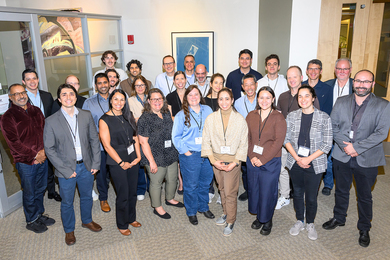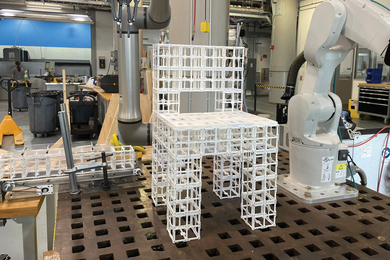More than 100 engineers from 18 countries took part in a workshop at the MIT Haystack Observatory in Westford from May 10-13 for operators of the global network of VLBI (very long baseline interferometer) stations.
The workshop provided technical training in all operational aspects of VLBI, including hands-on sessions, lectures, demonstrations and seminars. Included in the presentations was an introduction to Haystack's latest and most sensitive VLBI system, the Mark IV, which is expected to be up and running at observatories around the world by late next year.
The workshop -- popularly known as the chiefs' meeting because it offers technical training to staff members who are, or hope to become, one of the chief operators at their station -- is sponsored by NASA and by the European VLBI Network. The workshop was organized by the Haystack Observatory geodetic VLBI staff and the NASA Goddard Space Flight Center VLBI group.
"We are now completing the next generation of VLBI equipment, called Mark IV, which is being deployed worldwide. This is an opportunity to train engineers at various radiotelescope stations in the operations, the new equipment and procedures in general," said Joseph E. Salah, director of Haystack.
VLBI uses simultaneously operating radio telescopes around the world to monitor radio signals from distant sources, typically quasars in galaxies billions of light years away. The data are sampled and time-tagged according to atomic clocks operating at each site, and recorded on magnetic tapes.
The tapes are shipped to a VLBI correlator, such as the Mark III at Haystack, and processed with custom-designed hardware and controlling software that matches the pattern of radio waves from the distant radio sources. The hardware compensates for the different positions of the telescopes on the surface of the Earth and for the Doppler shift of the radio waves due to the Earth's rotation.
From this processing, the difference in time of arrival at the stations of the signals from the quasars is determined to a precision of a few picoseconds (light travels one millimeter in three picoseconds). Measuring these time differences from at least three sources makes it possible to calculate the distances between the receiving telescopes to a typical precision of better than one centimeter.
These distances are used to determine many geophysical properties, such as the velocities of the plates covering the Earth's surface and the changes in the Earth's rotation rate caused by El Ni���o. The correlator data are also of astrophysical interest because they can be used to make extremely high-resolution images of the extragalactic objects that are the source of the radio emission.
"The Mark IV VLBI system is an evolutionary improvement over the Mark III," said Arthur Niell, senior research scientist at Haystack. "With the Mark IV, the tapes from up to 32 telescopes can be fully correlated at one time, while the Mark III is limited to only four stations.
"The Mark IV also will allow correlation at much higher rates -- up to 2 billion samples per second per station, compared to 250 million for the Mark III -- providing a much more sensitive system and higher accuracy."
The Mark IV prototype is ready, and the complete correlator should be active by late 1999. Most recording-equipment upgrades at the telescopes should be completed by then, Dr. Niell said.
A version of this article appeared in MIT Tech Talk on May 13, 1998.





